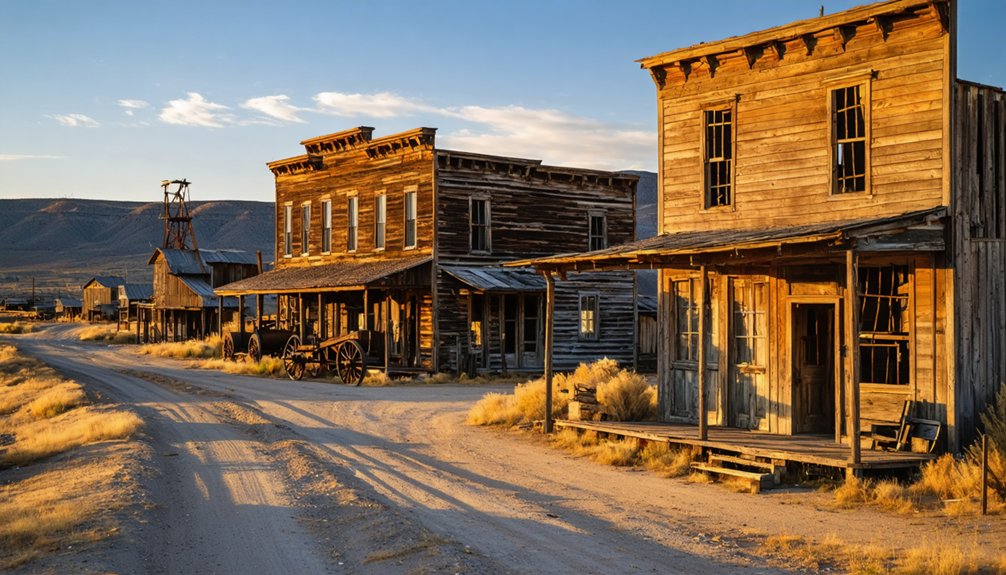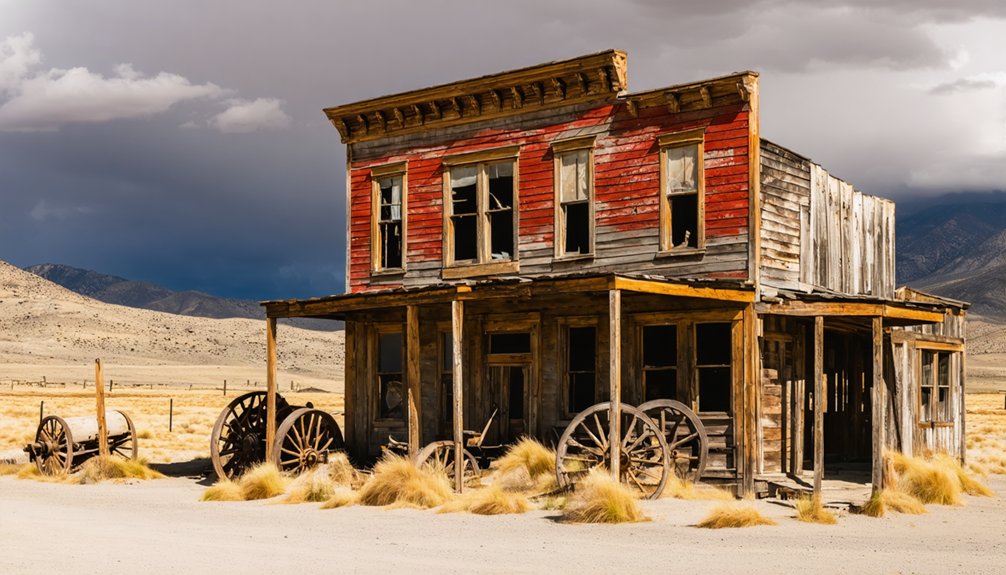Towns became ghost towns primarily when their economic foundations crumbled, especially during the 19th-century mining era. You’ll find that most ghost towns emerged when local mines were depleted or became unprofitable, forcing residents to leave. Transportation changes, like new highways bypassing communities, also led to abandonment. Environmental disasters and government decisions drove some populations away, while single-industry dependence left towns vulnerable. These fascinating settlements hold countless stories of boom, bust, and survival.
Key Takeaways
- Mining towns collapsed when mineral deposits were depleted, causing mass exodus as jobs disappeared and economic activity ceased.
- Environmental disasters and catastrophic events forced immediate abandonment, like nuclear accidents or toxic contamination.
- Changes in transportation routes, especially new highways and railroad closures, isolated communities from vital economic activity.
- Single-industry dependence left towns vulnerable when main employers shut down, triggering widespread unemployment and population decline.
- Government decisions, including military requisitions and environmental regulations, forced relocations and permanent abandonment of communities.
The Mining Boom and Bust Cycle
When rich mineral deposits were discovered in remote areas during the 19th century, mining boomtowns would spring up almost overnight.
You’d see thousands of prospectors rush to these sites, quickly establishing camps with basic amenities like supply stores, hotels, and saloons. Some towns, like Virginia City, Nevada, grew to over 25,000 residents within just a few years.
The harsh desert environment made sustaining these communities especially challenging.
Depleted natural resources often triggered mass exoduses from these settlements.
But these economic cycles were volatile and often short-lived.
Once the easily accessible ore ran out, mining technologies had to advance to reach deeper deposits, making operations more expensive. If gold or silver prices crashed, as they did in the 1893 silver panic, mines would shut down.
Without economic diversification, these towns couldn’t survive. People would pack up and leave, searching for the next boom, leaving behind empty buildings and abandoned dreams.
Shifting Transportation Routes and Infrastructure
As America’s transportation infrastructure evolved through the 20th century, entire communities vanished due to dramatic shifts in how people and goods moved across the country.
The rise of transportation innovations like diesel engines and automobiles reshaped the nation’s economic landscape, leaving many small towns behind.
You’ll find that towns originally established as railroad stops every 15-20 miles became obsolete when steam locomotives gave way to diesel.
When the Interstate Highway System emerged in the 1950s, it bypassed countless small communities, redirecting traffic and commerce to new routes.
Economic flow shifted away from businesses in towns with populations under 50,000 as travelers used the new highways.
Infrastructure investment concentrated in major metropolitan areas and highway-accessible locations, while towns along historic roads and railways saw their economies wither.
Without access to modern transportation networks, once-thriving communities dependent on rail service or old highway routes simply couldn’t survive.
Over 3,000 abandoned communities across America now stand as silent historical markers of this massive transportation evolution.
Environmental Disasters and Natural Hazards
You’ll find that environmental disasters can transform thriving communities into ghost towns virtually overnight through catastrophic events like nuclear accidents, toxic contamination, or devastating floods.
Natural hazards such as landslides, earthquakes, and underground fires have forced entire populations to permanently abandon their homes, as seen in cases like Craco, Italy and Centralia, Pennsylvania.
The gradual deterioration of environmental conditions, particularly from mining activities and industrial pollution, has also led to the slow death of numerous communities where mounting health risks and unstable ground made continued habitation impossible.
The tragic example of Pryp’yat, Ukraine demonstrates how a nuclear disaster can instantly render an entire city uninhabitable, leading to the permanent evacuation of all residents.
The devastating plane crash in Pyramiden in 1996 marked the beginning of the end for this remote Arctic settlement, leading to its eventual abandonment just two years later.
Sudden Catastrophic Events
Throughout history, sudden catastrophic events have transformed thriving communities into ghost towns within days or even hours.
You’ll find devastating examples like Times Beach, Missouri, where chemical contamination from dioxin-tainted oil forced a complete evacuation in 1983, requiring decades of cleanup.
Natural disasters have proven equally destructive – the 1889 Johnstown Flood claimed over 2,000 lives and demolished the town when a dam failed during heavy rainfall. The flood unleashed 14.55 million meters of water onto the unsuspecting town.
Dam construction itself has deliberately submerged entire communities, like Tignes, France, while disasters often trigger devastating chain reactions.
In Johnstown, fires spread through muddy streets after the flood.
The most insidious threats, like Centralia’s underground coal fire, can smolder for decades, releasing toxic fumes and creating sinkholes that make towns permanently uninhabitable.
Long-Term Environmental Decline
While sudden catastrophes can destroy towns overnight, long-term environmental decline often creates ghost towns through a gradual, relentless process.
You’ll find this pattern in coastal communities where rising seas and erosion slowly consume land, as witnessed in Burrwood, Louisiana, and Holland Island, Maryland.
In agricultural regions, soil erosion and desertification strip away farming viability, forcing residents to abandon their homes and fields – just as many did during the 1930s Dust Bowl. Vunidogoloa, Fiji exemplifies this pattern, where storm surges and cyclones eventually forced the entire village to relocate inland.
Mining towns face similar fates when resource depletion combines with environmental degradation. These towns often experience natural resource depletion that leads to widespread abandonment of once-thriving communities.
In Humberstone, Chile, and Russia’s Vorkuta region, the end of mining operations left behind polluted, economically depleted landscapes.
Agricultural decline follows as contaminated soil and water make farming impossible, creating a destructive cycle that ultimately empties these communities.
Government Decisions and Political Changes
Government decisions and political changes have played a decisive role in creating ghost towns across the globe, from direct interventions like military land requisitions to indirect effects of regulatory policies.
You’ll find examples like Tyneham, England, where military requisitions forced entire communities to relocate, and Picher, Oklahoma, where environmental contamination led to government-mandated evacuations.
Government policies have devastated mining and energy towns through overregulation, while political neglect left communities without essential support to adapt economically.
You can see this impact in Pennsylvania’s abandoned mines and blocked infrastructure projects like the Mountain Valley Pipeline. The closure of Emerald Mine in 2015 exemplifies how regulatory pressures can devastate local economies.
Transportation decisions, such as highway and railroad routing, determined which towns would thrive and which would fade away.
When combined with complex environmental regulations and land-use restrictions, these political choices often sealed a town’s fate.
Economic Dependencies and Industry Collapses

You’ll find that many ghost towns originated during the mining booms of the 19th century, when prospectors rushed to establish settlements near newly discovered mineral deposits.
These towns grew rapidly as mining operations expanded, but their fate was tied exclusively to the success of local mines and the value of extracted resources.
When the mines eventually depleted or became unprofitable, these single-industry towns lost their economic purpose, causing residents to abandon their homes and businesses in search of new opportunities.
Mining Boom and Bust
The dramatic rise and fall of mining towns perfectly illustrates how resource-dependent communities can collapse when their economic foundation crumbles.
You’ll find that these towns initially boomed when precious metals were discovered, but their fortunes were tied directly to finite resources and volatile global markets. As mining techniques evolved toward mechanization, fewer workers were needed, diminishing local economic resilience.
When ore deposits depleted or commodity prices plunged, mines would abruptly shut down, triggering devastating ripple effects throughout the community.
The closure of a single major mine could destroy an entire town’s economy, as seen in cases like Kitsault’s brief 18-month molybdenum operation or Cassiar’s 40-year asbestos mining run.
Without economic diversification, these single-industry towns couldn’t sustain themselves once their primary employer vanished.
Single Industry Dependencies
While thriving communities often emerge around dominant industries, excessive dependence on a single economic sector creates severe vulnerabilities that can devastate entire towns. When the primary employer closes, you’ll see a cascade of impacts: massive job losses trigger population exodus, property values plummet, and tax revenues collapse.
Without economic diversification strategies in place, communities can’t absorb these shocks. The ripple effects spread quickly through local businesses as worker spending evaporates. You’ll find empty storefronts, abandoned homes, and deteriorating infrastructure as cities struggle to maintain basic services.
While some towns attempt to recover through local entrepreneurship initiatives, the lack of capital and expertise often prolongs stagnation. This vulnerability to single-industry collapse continues to transform once-prosperous communities into modern ghost towns, especially when recovery planning comes too late.
Population Migration Patterns
Population shifts from rural communities to urban centers have created persistent demographic challenges, particularly among young adults aged 15-24 who exhibit the highest rates of outward migration.
You’ll find this youth outmigration pattern dramatically reshaping small towns, as young people leave to pursue education and employment opportunities in cities. While some may return in their late 20s after completing their education, it’s not enough to offset the initial exodus.
Young people fleeing small towns for urban opportunities create lasting demographic shifts that few returning residents can counterbalance.
This urban migration leaves behind aging populations with minimal newcomers to replace departing residents. You’re seeing a chain reaction: fewer young families mean fewer births, while deaths increase in the remaining elderly population.
The result is a natural population decline that, combined with continued outward movement, can transform once-vibrant communities into ghost towns.
Resource Depletion and Sustainability

Natural resource depletion stands as a primary driver behind ghost town formation, particularly in communities built around mining, logging, or other extractive industries.
You’ll find this pattern repeating throughout history, where towns rise rapidly during resource booms, then collapse when those resources run dry. Poor resource management and lack of economic diversification leave these communities vulnerable to sudden decline.
When natural resources become depleted or financially unfeasible to extract, you’re left with a devastating chain reaction. Jobs disappear, populations migrate, and environmental degradation often makes reoccupation difficult.
You can see this in places like Bodie, California, where gold mining created a bustling town that later became abandoned, or in Centralia, Pennsylvania, where underground coal fires forced residents to relocate permanently.
Community Infrastructure Breakdown
Infrastructure deterioration serves as a critical catalyst in the transformation of thriving communities into ghost towns. When essential utilities like water, electricity, and sewage systems fail due to infrastructure neglect, your town quickly becomes unlivable.
You’ll notice the domino effect as aging facilities crumble from lack of maintenance and funding. The impact of community disinvestment becomes evident when your local schools, hospitals, and post offices shut down.
You’ll find yourself traveling to larger cities for basic services, weakening your town’s economic foundation. Political instability often worsens the situation through inconsistent funding and poor governance.
When natural disasters strike, damaged infrastructure might never get repaired. Without reliable utilities and public services, businesses close, jobs disappear, and residents leave – accelerating the town’s descent into abandonment.
Frequently Asked Questions
Can Ghost Towns Legally Be Purchased and Restored to Functional Communities?
You can legally purchase ghost towns through proper property acquisition, but you’ll face restoration challenges involving infrastructure, permits, and regulations before transforming them into functional communities.
How Long Does It Typically Take for an Abandoned Town to Decay?
You’ll see initial decay processes within 5 years, but it takes 10-20 years for wooden structures to crumble and 30-50 years for brick buildings, making urban exploration increasingly dangerous.
What Happens to Property Rights and Land Ownership in Ghost Towns?
You’ll find property rights remain intact despite abandonment, though ownership often becomes complex with property disputes and land reclamation efforts. You’ll need legal documentation to claim or purchase ghost town parcels.
Do Any Ghost Towns Maintain Permanent Caretakers or Security Personnel?
While most ghost towns stand empty, you’ll find dedicated caretakers like Brent Underwood managing preservation at Cerro Gordo. Security measures vary, with tourist sites maintaining staff but remote locations typically relying on lone stewards.
How Do Modern Ghost Towns Differ From Historical Ones in Preservation?
You’ll find modern preservation focuses on curated storytelling and controlled decay, unlike historical ghost towns that deteriorated naturally. Today’s sites actively maintain structures and emphasize educational value through planned heritage tourism.
References
- https://history.howstuffworks.com/history-vs-myth/ghost-towns.htm
- https://en.wikipedia.org/wiki/Ghost_town
- https://www.britannica.com/topic/ghost-town
- https://kids.kiddle.co/Ghost_town
- https://texashighways.com/culture/history/what-the-heck-is-a-ghost-town/
- https://www.legendsofamerica.com/gt-ghosttownethics/
- https://www.youtube.com/watch?v=ZiJctD8Cs70
- https://grokipedia.com/page/Ghost_Town
- https://travelnevada.com/nevada-magazine/ghost-town-primer/
- https://www.altaonline.com/dispatches/a6466/ghost-town-wild-west-laura-fraser/



